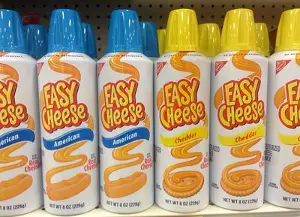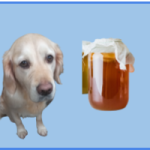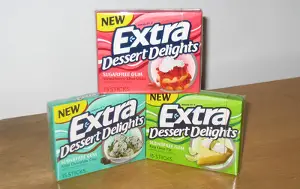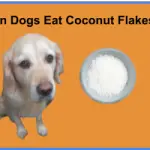
Easy Cheese is a type of cheese that is stored in a spray can.
It was first introduced in America in the mid 1960s.
When it was launched it was first known as “Snack Mate”.
One of the taglines was “instant cheese for instant parties”.
But is this kind of instant cheese ideal for your dog?
To start with, I want to give you a nice and simple answer.
Can dogs eat Easy Cheese?
Yes, your dog can eat Easy Cheese.
And there are also lots of other processed cheeses that I look at in this article which are safe for your dog to eat.
But let’s not kids ourselves: Easy Cheese isn’t a healthy snack for your dog by any stretch of the imagination.
It is quite high in fat and cholesterol and very high in salt.
So just use it very sparingly.
The rest of this article will be a deep dive into Easy Cheese.
And I want to start by looking at the ingredients.
What are the ingredients in spray cheese?
Easy cheese comes in two flavours- Cheddar and American.
Both of these flavours have the same six main ingredients.
And they are: Whey, canola oil, milk protein concentrate, cheddar cheese (milk, salt, cheese culture and enzymes) and milk.
So those first two ingredients might need a bit of explaining.
Part of the process of making cheese is that milk is left to curdle- which is when it starts to form into rubbery lumps.
Whey is the liquid that remains after these lumps have formed.
Canola oil is a type of vegetable oil which is derived from rapeseed.
The difference in the ingredients comes from some of the minor ingredients.
And by minor I mean any ingredient which makes up less than 2% of the total.
And these ingredients read like a list of chemicals.
They include a couple of phosphates and a couple of acids.
All the things that when they are mixed together, keep the cheese edible in a can.
So how does this compare to the ingredients in a standard block of cheddar?
Let’s see shall we?
Easy Cheese vs cheddar
In contrast, a block of medium cheddar just contains milk, salt, enzymes and some colouring (annatto.)
So the biggest difference between the ingredients in a can of easy cheese and a block of cheddar is them is the whey and the canola oil
Nutrition wise, the surprising thing is that the cheddar contains more fat and cholesterol.
But, Easy Cheese contains a huge amount of salt- way more than the block of cheddar.
Now, Easy Cheese isn’t the only canned cheese on the block (if you can believe that.)
There are rival products out there.
And I will look at two of them in the next section.
Kong Cheese vs Cheez Whiz
Kong Cheese comes in a can and is made by the same people who make the dog toy.
Clever stuff isn’t? To make a toy and then make a product to fill it with.
And a quick look at the ingredients shows that Kong Cheese is very similar to Easy Cheese.
Kong cheese contains lots of whey and oil (soybean but canola) as well.
But what about Cheese Whiz?
Well Cheese Whiz doesn’t come in a can.
Instead it comes in a glass jar and is spreadable, like peanut butter.
And a look at the ingredients shows that Cheese Whiz has very similar ingredients to Easy Cheese as the main ingredients are; whey, milk and canola oil.
So having given a brief overview of all of these similar products, it is time to think about the possible advantages and disadvantages to Easy Cheese.
As far as your dog is concerned.
What is good about spray cheese for dogs?
Normally in this section, I focus on all the positive nutritional aspects of the food that I’m writing about and then describe how these might then boost the health of your dog.
But it is hard to do that with Easy Cheese because there is so little of the nutritional content.
I mean I could talk about some of the good nutrition that is in a can but I think that would be stretching it a bit.
I think the advantages of Easy Cheese have little to do with nutrition and everything to do with the fact it is in a can.
And cheese in a can means that this tasty dog treat is portable and it is convenient.
I think that portability is very important because dogs go with us to lots of different places.
So, for instance, if you were using Easy Cheese as a training treat it would be nice and easy to take it to the park with you.
And not only is it portable, it is also convenient.
And what I mean by convenient is that it is easy and clean to use.
It isn’t like using real cheese for a training treat because real cheese will need to be cut up and stored in a container.
And think of all the clearing up that there is to do with that?!
Well having steered clear of nutrition, in the next section I will talk about nothing but.
What is bad about spray cheese?
The bad stuff about spray cheese are the ingredients.
Easy Cheese isn’t real food, it is highly processed.
It has very few real ingredients and contains lots of additives and preservatives.
Consequently it is relatively high in fat and incredibly high in salt- neither of which are any good for your dog.
Too much fat in a dog’s diet will lead to issues such as obesity.
And too much salt in a diet could result in your dog having high blood pressure.
And there is another reason why Easy Cheese is bad.
Pound for pound it is so expensive.
At Walmart an 8 oz can will cost you about $5.
Which means that you will pay nearly $10 for a lb.
A pound block of real Cheddar from a popular brand will cost you a mere $6.00 per pound.
How much spray cheese should I feed to my dog?
My general advice about the amount of spray cheese that you should be feeding to your dog, is as little as you can get away with.
This is for the health of your dog and the health of your wallet or purse.
Not only are there a lot of calories in this cheese but I would think that it is highly addictive and your dog might start developing a habit.
I’m thinking here about feeding your dog grape-size squirts of this cheese or as opposed to golf ball sized squirts.
And don’t feed it to them too often.
Just a few squirts per day.
If you are using it as a training treat, then use it in conjunction with other training treats.
Is Easy Cheese OK for puppies?
There is nothing toxic in spray cheese either for an adult dog or a puppy.
With this in mind, go ahead and use it here and there with your puppy.
The only concern that I have about using such addictive substances with young dogs is that if they get too attached to a treat, it might put them off eating their main meal- which then leads to a slippery slope.
Can dogs eat Kraft Singles?
Yes, your dog can eat Kraft Singles.
These are the individually wrapped pieces of processed cheese that people add to their sandwiches or burgers,
And my advice remains the same.
These are a healthy or nutritious product for your dog and so if you want to feed Kraft Singles to your dog, just don’t make it a daily habit.
After looking at the ingredients, there is nothing there which is toxic for dogs.
And in fact, the ingredients look very similar to the ingredients of Easy Cheese with one main exception.
Kraft Singles don’t contain any oil.
Can dogs eat Laughing Cow wedges?
The final processed cheese product that we will be looking at are Laughing Cow wedges.
Now these are made from a combination of Cheddar, Swiss and Semi Soft cheeses with added ingredients.
And it isn’t these main ingredients that are an issue for me.
There are a range of Laughing Cow flavours and each flavour has slightly different ingredients.
And one of these flavours worries me as far as your dog is concerned.
And that is “Creamy Garlic and Herb”.
The reason why this flavour worries me is because onion and garlic are both on the ingredient list.
Onion and garlic are both poisonous to dogs.
Although they are pretty minor ingredients, because we’re not sure exactly how much of them the product contains, my advice would be to steer clear.
Photo credits
¹ Photo by Mike Mozart on Flickr






